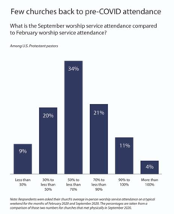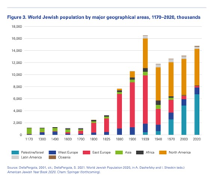
![]() The most recent wave of the New Congregations Study (NCS) finds that the trend toward informal and more enthusiastic forms worship shows no signs of plateauing while the ethnic diversity of American congregations has increased significantly, with the percentage of all-white congregations decreasing. The newest NCS results, compared with earlier waves of the survey, were published in articles by Mark Chaves (along with Kevin Dougherty, Michael Emerson, Kraig Beyerlin, Joseph Rosso, and Anna Holleman) in the Journal for the Scientific Study of Religion (online in October). The increasing popularity of contemporary and enthusiastic services (especially music) was seen across the board, but the trend is particularly evident in white
The most recent wave of the New Congregations Study (NCS) finds that the trend toward informal and more enthusiastic forms worship shows no signs of plateauing while the ethnic diversity of American congregations has increased significantly, with the percentage of all-white congregations decreasing. The newest NCS results, compared with earlier waves of the survey, were published in articles by Mark Chaves (along with Kevin Dougherty, Michael Emerson, Kraig Beyerlin, Joseph Rosso, and Anna Holleman) in the Journal for the Scientific Study of Religion (online in October). The increasing popularity of contemporary and enthusiastic services (especially music) was seen across the board, but the trend is particularly evident in white  congregations in line with prominent megachurches, and networks, but also in Catholic and mainline churches. In 1998, 72 percent of main services followed a written order, 53 percent used an organ, and 54 percent had a choir. By 2018, 66 percent used a written order, 47 percent used an organ, and 46 percent had a choir. Related to this development is growth in the use of technology, such as video projection and more recently the use of smart phones (one-third used smart phones in the most recent survey).
congregations in line with prominent megachurches, and networks, but also in Catholic and mainline churches. In 1998, 72 percent of main services followed a written order, 53 percent used an organ, and 54 percent had a choir. By 2018, 66 percent used a written order, 47 percent used an organ, and 46 percent had a choir. Related to this development is growth in the use of technology, such as video projection and more recently the use of smart phones (one-third used smart phones in the most recent survey).
On racial diversity, the NCS study found that there are now more congregations in which no one racial or ethnic group comprises more than 80 percent of the people (going from six percent in 1998 to 16 percent in 2018-2019). The increase in diversity was seen in mainline and evangelical churches. In 1998, only one in 100 mainline churches met the threshold of having no group with an 80 percent representation in congregations; today it is one in 10 that reached that point. For evangelicals, only seven percent of congregations had this measure of diversity in 1998 while 22 percent do in 2018-2019. Leadership in all of these churches have likewise become more diverse. Sixteen percent of these diverse congregations had black clergy in 2018-19 compared to just four percent in 1998. On politics, the new survey finds a continuing growth of mobilization on social and political issues. This is especially the case with black churches, which experienced a surge in activism since 2012. Going somewhat against the popular storyline, liberal congregations mobilizing on political issues (such as on immigration) have grown faster than conservative congregation mobilization (though there are more politically conservative congregations overall). The researchers found an unexpectedly large minority of congregations (17 percent) that would endorse a political candidate if it did not risk their tax-exempt status.
(Journal for the Scientific Study of Religion, https://onlinelibrary.wiley.com/toc/14685906/current)
![]()
While a large majority of U.S. Protestant churches say they are holding in-person services, many churchgoers have yet to attend in the numbers they did before the pandemic struck, according to a survey from Nashville–based LifeWay Research. It is found that 87 percent of Protestant pastors in the U.S. say their church met in person in September, while 13 percent did not hold such  services. The survey found that one in 10 churches say their attendance in September was less than 30 percent of what it was in February before COVID arrived in the U.S. Another 20 percent say attendance was between 30 percent and less than 50 percent of what it was. The survey found that one-third of clergy (34 percent) say it has reached 50 percent to less than 70 percent of previous levels. For only one in five pastors, attendance is between 70 percent to less than 90 percent. The researchers estimate that more than 1 in 10 churches are still not meeting in person for any type of worship service. Mainline pastors (31 percent) are more likely than evangelical pastors (7 percent) to say they did not physically gather in September. Methodists (22 percent) and Presbyterian/Reformed (23 percent) are more likely to say they did not meet in person than Lutherans (12 percent), pastors in the Restorationist movement (10 percent) or Baptists (9 percent). The report notes that social distancing may be easier in churches, as most pastors find that their congregations have less than 70 percent of their preCOVID attendees.
services. The survey found that one in 10 churches say their attendance in September was less than 30 percent of what it was in February before COVID arrived in the U.S. Another 20 percent say attendance was between 30 percent and less than 50 percent of what it was. The survey found that one-third of clergy (34 percent) say it has reached 50 percent to less than 70 percent of previous levels. For only one in five pastors, attendance is between 70 percent to less than 90 percent. The researchers estimate that more than 1 in 10 churches are still not meeting in person for any type of worship service. Mainline pastors (31 percent) are more likely than evangelical pastors (7 percent) to say they did not physically gather in September. Methodists (22 percent) and Presbyterian/Reformed (23 percent) are more likely to say they did not meet in person than Lutherans (12 percent), pastors in the Restorationist movement (10 percent) or Baptists (9 percent). The report notes that social distancing may be easier in churches, as most pastors find that their congregations have less than 70 percent of their preCOVID attendees.
(This study can be downloaded here: https://lifewayresearch.com/2020/10/20/few-churchesback-to-pre-covid-attendance-levels/)
![]() Official membership statistics do not necessarily provide a reliable way of quantifying size, but membership data may either overstate or underestimate the numbers, write Ronald Lawson (Queens College) and G. Kenneth Xydias in an attempt at reassessing the number of Mormons, Seventh-day Adventists and Jehovah’s Witnesses in the Review of Religious Research, (September, 2020). While many researchers are aware of such issues, the article not only provides fresh insights based on a comparison between official data of each group and census from 54 countries (complemented by data from five surveys for the US), but offers a comparative approach between those three dynamic, missionary-minded religious organizations. In 2017, the Church of Jesus Christ of Latter-day saints claimed 16,118,169 members (increase 1.5 percent), the Seventh-day Adventists 20,727,347 members (increase 3.6 percent) and the Jehovah’s Witnesses 8,242,992 “publishers” on average (increase 1.4 percent). As the name for the third group suggests, the way of counting differs from one group to another. Witnesses only count those active in witnessing.
Official membership statistics do not necessarily provide a reliable way of quantifying size, but membership data may either overstate or underestimate the numbers, write Ronald Lawson (Queens College) and G. Kenneth Xydias in an attempt at reassessing the number of Mormons, Seventh-day Adventists and Jehovah’s Witnesses in the Review of Religious Research, (September, 2020). While many researchers are aware of such issues, the article not only provides fresh insights based on a comparison between official data of each group and census from 54 countries (complemented by data from five surveys for the US), but offers a comparative approach between those three dynamic, missionary-minded religious organizations. In 2017, the Church of Jesus Christ of Latter-day saints claimed 16,118,169 members (increase 1.5 percent), the Seventh-day Adventists 20,727,347 members (increase 3.6 percent) and the Jehovah’s Witnesses 8,242,992 “publishers” on average (increase 1.4 percent). As the name for the third group suggests, the way of counting differs from one group to another. Witnesses only count those active in witnessing.
Mormons count baptized members and also most children in active Mormon families. Adventists count only baptized members, but not children, although they would have been dedicated in church ceremonies as infants. Comparing official data and census data from 54 countries around the world compiled by Lawson and Xydias shows the Mormon official data to be greatly inflated, since those identifying as Mormons are  less than one-third of those on official rolls. This may be due to the high attrition rate among new converts (especially in the developing world) and the impact of secularization in the West. As expected, since the organization does not count children, official census shows a ratio of 1.34 to 1 in comparison with Adventist data, but given the large number of unbaptized children in developing countries, this shows the official data still to be exaggerated. Regarding the Witnesses, there are twice more people claiming to be Witnesses than those counted as “publishers”, which cannot only be explained by unbaptized children, but also by not yet baptized adults who already see themselves as Witnesses, by free riders who adopt a Witness identity without becoming publishers, and by lapsed or unactive Witnesses still identifying as such.
less than one-third of those on official rolls. This may be due to the high attrition rate among new converts (especially in the developing world) and the impact of secularization in the West. As expected, since the organization does not count children, official census shows a ratio of 1.34 to 1 in comparison with Adventist data, but given the large number of unbaptized children in developing countries, this shows the official data still to be exaggerated. Regarding the Witnesses, there are twice more people claiming to be Witnesses than those counted as “publishers”, which cannot only be explained by unbaptized children, but also by not yet baptized adults who already see themselves as Witnesses, by free riders who adopt a Witness identity without becoming publishers, and by lapsed or unactive Witnesses still identifying as such.
The organizations have been aware of those issues. In the early 2000s, the Adventists conducted an audit and cleaning of its rolls, leading to the removal of nearly half of those listed in some countries. The LDS Church headquarters have asked that the newly baptized believers should only be listed as members after about one month if still present, and efforts have been made for reclaiming inactive members. Regarding the Witnesses, only “publishers” are fully considered as such, but they also provide the total attendance at the yearly Memorial of Christ’s death, which comes closer to the total of those having some kind of connection to the organization. Depending upon adjustment methods used, Lawson and Xydias come to an estimate of between 6.6 million and 10.3 million Mormons for 2017, more than 27 million Adventists, and more than 17 million Witnesses. Such figures thus include active members, their children, and those self-identifying themselves as belonging to that religious culture or sphere without necessarily being active in some way. The authors stress that “variation in attrition has had a major impact on the growth rates of all three groups.”
(Review of Religious Research, https://www.springer.com/journal/13644)
![]()
Between 1970 and 2020, Europe lost 59 percent of its Jewish population, and the proportion of world Jewry living in Europe today is almost identical to the proportion living in Europe 900 years ago, according to a study authored by Daniel Staetsky and Sergio DellaPergola, that was released by the London-based Institute for Jewish Policy Research on October 21. Covering one thousand years of European Jewish history, the 84-page long report is presented as “the most comprehensive analysis of European Jewish demography today.” The self-understanding of the essence of Jewish identity differs from one European country to another, which has an impact on the assessment of Jewish demography and may lead to different numbers in going from one source to another. According to the 2018 European Union Agency for Fundamental Rights (FRA) survey on Jewish perceptions of antisemitism, 61 percent of Jews in the UK see religion as the prime component of their identity, but only 9 percent of Hungarian Jews would see it in the same way (while 54 percent of them answered that it is Jewish culture).
Whatever slight variations this might imply, the demographic changes in the Jewish population of Europe have been dramatic. During the Middle Ages and the early modern era, the Jewish population stagnated around one million. There was an impressive rise during the 19th  century, culminating in a high range figure of 16.5 million on the eve of WWII. Europe (including Jewish emigration from Europe to North America) was the primary factor for such a growth. The tragic events of the war brought the global Jewish population down to 11 million and a strong diminution of the share of European Jews. In 1939, 58 percent of the Jews lived in Europe (50 percent in Eastern Europe and 8 percent in Western Europe). “By 1945 the European share of world Jewry had fallen to 35 percent, and it fell further to 26 percent in 1970 and to 9 percent in 2020.” This post-WWII decline took place mostly in Eastern Europe, “whose share of the global total diminished from 26 percent in 1945 to 17 percent in 1970 to 2 percent in 2020.” Between 1970 and 2020, there was thus a drastic decline of 85 percent in Eastern Europe, due to the emigration of 1.8 million Jews, with 1 million of them going to Israel.
century, culminating in a high range figure of 16.5 million on the eve of WWII. Europe (including Jewish emigration from Europe to North America) was the primary factor for such a growth. The tragic events of the war brought the global Jewish population down to 11 million and a strong diminution of the share of European Jews. In 1939, 58 percent of the Jews lived in Europe (50 percent in Eastern Europe and 8 percent in Western Europe). “By 1945 the European share of world Jewry had fallen to 35 percent, and it fell further to 26 percent in 1970 and to 9 percent in 2020.” This post-WWII decline took place mostly in Eastern Europe, “whose share of the global total diminished from 26 percent in 1945 to 17 percent in 1970 to 2 percent in 2020.” Between 1970 and 2020, there was thus a drastic decline of 85 percent in Eastern Europe, due to the emigration of 1.8 million Jews, with 1 million of them going to Israel.
Although there will no longer be such large numbers of migrants in the future, surveys show that a percentage of the Jewish population in each European country considers migration to Israel or elsewhere, and the trend has been rising during the past five years. While a majority of European Jews are not planning to migrate, the percentage of those who do is bound to have an impact and cannot be compensated for by immigration. Moreover, an aging process is taking place—more than 40 percent of the Jews in Germany are above the age of 65. Conversions to Judaism are taking place (in part through marriage), but it is impossible to assess how far this can make up for the numbers of people leaving Judaism. “Today, European Jewry amounts to about 1.3 million, with two in three people living in one of three countries – France, the United Kingdom or Germany.” The authors stress that “the absolute number of Jews counts more than the relative percentage of Jews in a country.” They hypothesize that a minimal numerical threshold of viability and performance of 8,000 Jews should allow them to organize sufficient services for supporting community life.
(The report, titled, Jews in Europe at the turn of the Millennium: Population trends and estimates, can be downloaded from https://www.jpr.org.uk/publication?id=17623).